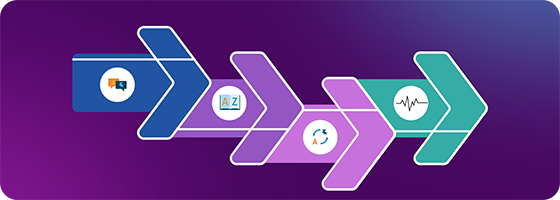Video Transcription 101: Benefits, Use Cases, & Accessibility
Making Accessible, Engaging Video Content: The Hows and Whys of Video Transcription
Video transcription is hitting its stride in various sectors, from education to media. The demand for this service is on the rise for multiple reasons, including improved accessibility and user engagement. Briefly, video transcription is the process of converting audio from a video into text. This can be done manually or automatically using speech recognition software.
Let's dive into what video transcription is and why it's a big deal.

What is Video Transcription, and How Does it Work?
Video transcription is the process of converting the spoken words in a video into written text. It’s not too different from the note-taking you may remember from school: a person writing down what they hear. This can be done either manually by a person or automatically with AI tools. It involves listening to the video, typing out the audio, and syncing the text correctly with the video timeline.
Manual vs. Automated Transcription
There are two main types of video transcription: manual and automated.
Manual transcription is done by a human transcriber who listens to the audio and types the text into a document. There's a core difference between getting a person to transcribe video to text and using an automated service like AI video transcription. Manual is the most accurate type of transcription, but it is also the most time-consuming and expensive.
Automated transcription is done using speech recognition software. This is the fastest and most affordable type of transcription, but it is not as accurate as manual transcription.
The most common process combines some manual and automated video transcription. It can be broken down into the following steps:
- A video is uploaded to a transcription service.
- The audio from the video is converted into text using speech recognition software.
- The text is reviewed and edited by a human transcriber.
- The transcribed text is delivered to the customer.

When to Use Manual Transcription
Manual transcription is required for videos that contain important or sensitive information, such as legal proceedings or medical consultations. Manual transcription is usually more accurate, and can catch nuances that AI may miss. It is also more beneficial for videos that have complex or technical language. It's particularly useful for videos with several languages spoken, heavy jargon, poor audio quality, or multiple speakers talking at once.
Use Cases Across Industries
Video transcription can be used in many industries, including:
Education
Video transcription is popular for online courses. It can be used to create transcripts of lectures, tutorials, and other educational materials. This makes it easier for students to access and learn from the content.
Corporate
Video transcription can be used to create transcripts of meetings, interviews, and other corporate communications. Transcribed meetings and seminars can serve as a reference and increase productivity. This can also help improve communication and collaboration within the organization.
Media & Entertainment
Video transcription can be used to create transcripts and subtitles of news broadcasts, documentaries, and other media content. This makes it easier for people to access and understand the content. Video transcription helps content reach a broader audience.
Healthcare
Video transcription plays a critical role in healthcare settings, aiding in the accurate documentation of patient consultations and clinical studies. Video transcription can be used to create transcripts of doctor's appointments, therapy sessions, and other healthcare-related communications. This can help improve patient care and compliance with regulations. Transcriptions can be vital for record-keeping and future reference, letting no crucial detail go missing.
Companies: Mayo Clinic, Teladoc
Legal
In the legal sector, accurate transcriptions of hearings, depositions, and interviews are essential. Video transcription services are commonly used to convert courtroom proceedings and legal consultations to text for easier review and archiving. Video transcription can be used to create transcripts of depositions, trials, and other legal proceedings. This can help keep the proceedings accurate, and give all parties access to the same information.
Companies: LexisNexis, Clio
By integrating video transcription across various sectors like education, corporate, media, healthcare, and legal, organizations make their content accessible and easy to digest. This not only improves the user experience but also confirms that critical information is available in multiple formats.
Three Benefits of Transcription
Increased Accessibility
Video transcription can make your content accessible to those who are hearing-impaired or have other disabilities.
SEO Benefits
Search engines can crawl text more easily than audio, giving you a higher rank.
Improved User Engagement
Offering video and text options can increase the time users spend on your site.
Laws and Guidelines to Follow
Both the Americans with Disabilities Act (ADA) and Web Content Accessibility Guidelines (WCAG) provide the framework for web accessibility. To stay compliant, make sure to offer transcriptions for all video and audio content on your website. Use proper headings and formats that work well with screen readers.
The ADA (US) requires businesses and organizations to provide reasonable accommodations to people with disabilities. This can include providing video transcriptions for videos that are essential to the business or organization.
The WCAG are a set of international accessibility guidelines for websites and web content; these guidelines are accepted as standard throughout most of the world. WCAG 2.1 requires that all videos on websites have transcripts or captions.
While there are many guidelines and legal regulations in various countries and states, the two we’ve mentioned are often referenced, and their requirements can be used as a set point to work towards. If your local regulations require something different, the discrepancies are likely to be slight.
Best practices for following accessibility guidelines
- Provide transcripts for all videos that are essential to your business or organization.
- Make sure the transcripts are accurate and easy to understand.
- Use a transcription service that is compliant with accessibility guidelines.
- Test your videos with people with disabilities to make sure they are accessible.
- Lean towards using manual transcription in cases where it may be necessary.
Accessibility Through Transcription
When you transcribe video to text, you're doing more than just offering convenience; you're making content accessible to a wider audience. By adding text to videos, you make them easier to understand for people who may have hearing difficulties. This aligns with a11y and WCAG guidelines, advocating for a more inclusive web.
Video transcription is a valuable tool that also improves the accessibility, SEO, and user engagement of videos. By following the best practices outlined in this article, you not only make your videos accessible to everyone, you’re making a good business decision.
In summary, video transcription is versatile, and brings many benefits. It's a service that's changing how we consume content, making the digital world a bit more inclusive for everyone.
FAQs
How does video to text transcription work?
You can either hire a professional to transcribe the video manually, or use an AI video transcription service. Both methods aim to convert spoken words into written text.
Are there any free AI video transcription tools?
Yes, some platforms offer basic video audio transcription features for free but may have limitations on the length of the video or the quality of the transcription.
What are the best practices for making video transcriptions accessible?
Follow the WCAG guidelines for text formats and make sure that the transcriptions are compatible with screen reading software.









